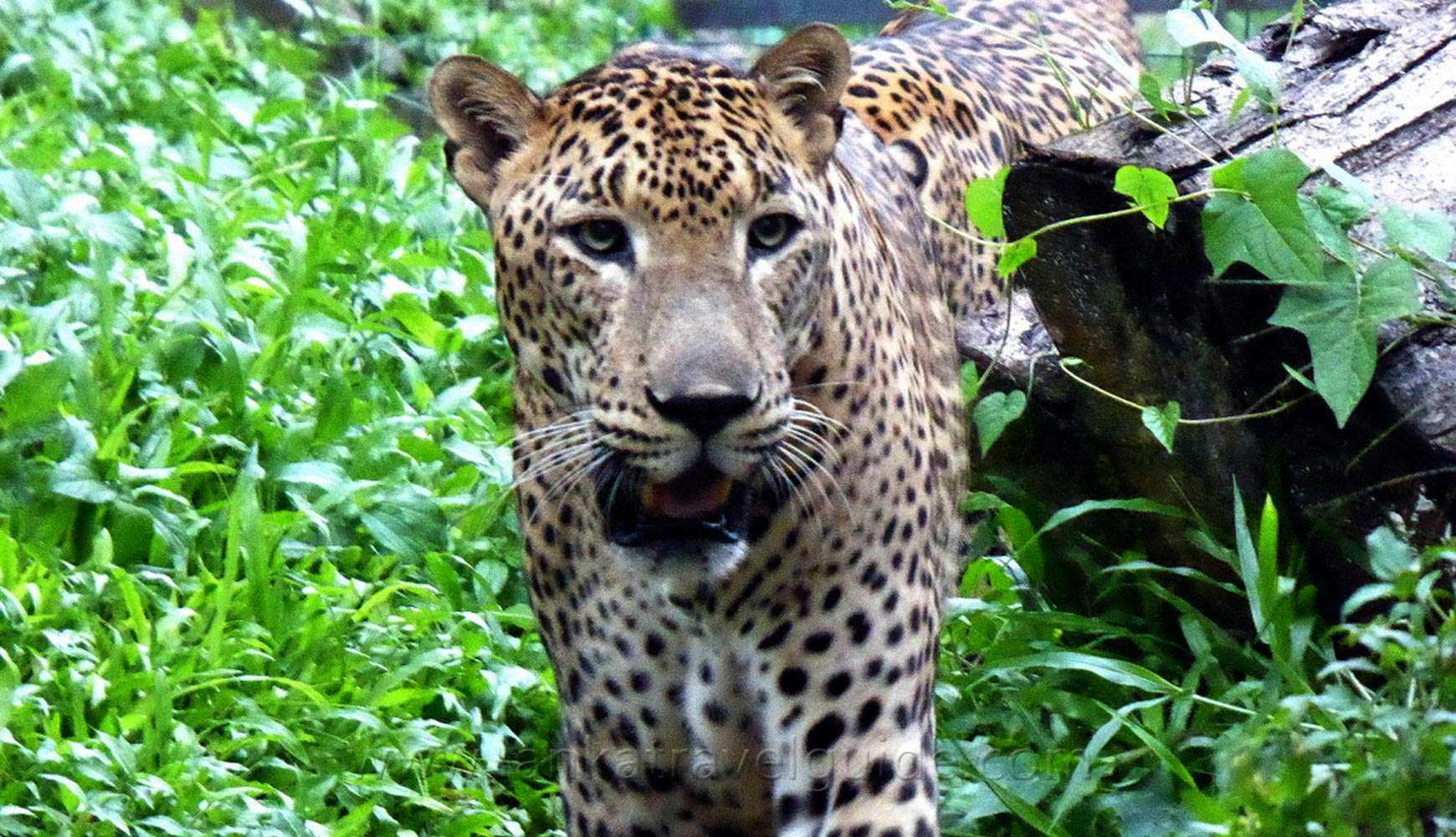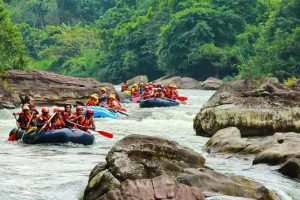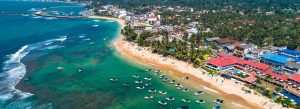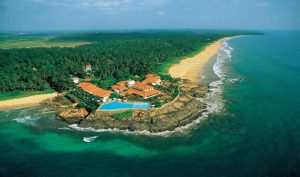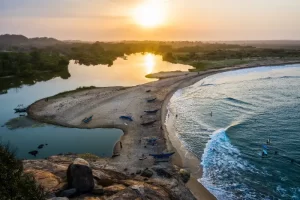Singharaja Forest is the most famous rainforest of Sri Lanka. Also referred as Sinharaja Forest Reserve, the location of the Sinharaja Rain Forest is in the South Western part of the island and covers an area of 11,187 Hectares.
The Sinharaja forest has been declared a World Heritage Site by UNESCO in 1989, because of its unique and high biodiversity and its importance to the island’s ecosystem. The Sinharaja Forest is well worth a visit from anyone who is interested in the natural resources of this country.
Sinharaja is bordered by rivers on three sides. On the north, Sinharaja is bounded by the Napola Dola and Koskulana Ganga. On the south and south-west are the rivers Maha Dola and Gin Ganga. On the west are the river Kalukandawa Ela and river Kudawa Ganga. To the east of Sinharaja is an ancient footpath near Beverley Tea Estate and by the Denuwa Kanda.
Anyone who’s interested in experiencing the natural beauty of this last major undisturbed area of rainforest in this country can reach the forest via a few routes. From Northern or western parts of the country you can reach Sinharaja Forest Reserve via Ratnapura, Kiriella, Kalawana, Weddala. From the South you can enter Sinharaja Rain Forest from Deniya. Coming from Hambantota, Udawalawe you can enter Sinharaja from the Rakwana side. Once you enter the borders of the rainforest, the only way to get about the reserve is by foot, and excellent park guides, or freelance guides are available through many hotels, and can lead you along slippery trails pointing out the wealth of stunning plant, bird and animal-life.
Tropical rain forests need to have three main factors in common. First, there should be bright sunlight, secondly there needs to be a high rainfall, distributed all along the year and also a high temperature. This makes the region very humid. Only Sinharaja and few other scattered forest cover of lesser extent in land area in the Southern Western part of Sri Lanka fulfils the above criteria. Meteorological records gathered from in and around Sinharaja over the last 60 years reveal the annual rainfall of Sinharaja Forest has ranged between 3614mm to 5006mm and temperatures from 19°C to 34°C. The high rainfall is owing to two monsoons: south-west monsoons during May-July and the north-east monsoons during November-January.
Sinharaja has a wild profusion of flora. The canopy trees reach heights of up to 45m, with the next layer down topping 30m. Nearly all the subcanopy trees found here are rare or endangered. More than 65% of the 217 types of trees and woody climbers endemic to Sri Lanka’s rainforest are found in Sinharaja.
As a rainforest with its rich and complex diversity of vegetation, Sinharaja provides habitats for a variety of animals. Out of 12 endemic mammal species of the country 8 are found here. Giant squirrel, dusky-stripped jungle squirrel, badger mongoose and endemic purple-faced leaf monkey and torque macaque are frequently seen. Many threatened species of mammals, reptiles, amphibians and butterflies are found in the Reserve including the leopard which is the largest carnivore found in the Sinharaja forest. Its presence can usually be gauged only by droppings and tracks, and it’s seldom seen. Even rarer are rusty spotted cats and fishing cats. Sambar, barking deer and wild boar can be found on the forest floor. Groups of ten to fourteen purple-faced langurs are fairly common. There are three kinds of squirrels: the flame-striped jungle squirrel, the dusky-striped jungle squirrel and the western giant squirrel.
Porcupines and pangolins waddle around the forest floor, mostly unseen. Civets and mongooses are nocturnal, though you may glimpse the occasional mongoose darting through the foliage during the day. Six species of bats have been recorded here.
Sinharaja Forest reserve is also home to over 50% of Sri Lanka’s endemic species of mammals and butterflies, as well as many kinds of insects, reptiles and rare amphibians. Sinharaja has 45 species of reptiles, 21 of them endemic. Venomous snakes include the green pit viper (which inhabits trees), the hump-nosed viper and the krait, which lives on the forest floor. One of the most frequently found amphibians is the wrinkled frog, whose croaking is often heard at night.
Sinharaja Forest reserve is also home to over 50% of Sri Lanka’s endemic species of mammals and butterflies, as well as many kinds of insects, reptiles and rare amphibians. Sinharaja has 45 species of reptiles, 21 of them endemic. Venomous snakes include the green pit viper (which inhabits trees), the hump-nosed viper and the krait, which lives on the forest floor. One of the most frequently found amphibians is the wrinkled frog, whose croaking is often heard at night.
There is a wealth of birdlife. Over 147 species have been recorded to be living in this forset. This variety of species is possible because of the availability of specific habitats that range from 300 to 1500 meters. There are many endemic birds such as Ceylon Lorikeet, Layard’s Parakeet, Ceylon Jungle Fowl, Spur Fowl, Ceylon White-headed Starling, Ceylon Wood Pigeon, Grey Hornbill, Spotted-wing Thrush, Rufous Babbler, Brown- capped Babbler, Ashy-headed Laughing Thrush, Ceylon Blue Magpie, White Headed Starling, Green-billed Coucal, Red-faced Malkoha, Ceylon Hill Mynah or Grackle and Legge’s Flowerpecker are some of the endemic birds found at Sinharaja.
The Sinharaja Forest is also considered a Cultural Heritage. The Sinharaja region has long featured in the legends and lore of the people of Sri Lanka. Its name, literally meaning lion (sinha) king (raja), perhaps refers to the original ‘king-sized or royal forest of the Sinhalese’, a people of the legendary ‘lion-race’ of Sri Lanka, or to the home of a legendary lion of Sri Lanka.
Sinharaja is surrounded by 22 villages with a population of approximately 5000 people. Only two villages, Warukandeniya and Kolonthotuwa are located within the reserve.
The long history of human habitation in and around today’s reserve, in fact compounds the problem of managing and conserving the forest. Most of the ancient harmless are found along the southern boundary of the reserve on the bank of Gin Ganga with a few located on the north- western side. Numerous ancient footpaths exist on the periphery of the reserve while there are three footpaths that run across the interior of the forest.
Sinharaja has leeches in abundance. In colonial times the British, Dutch and Portuguese armies rated leeches as their worst enemy when they tried to conquer the hinterland, which was then much more forested, and one British writer claimed leeches caused more casualties than all the other animals put together. These days you needn’t suffer as much because all guides carry antileech preparations.
The best time to visit the Sinharaja and to experience the beauty and enchantment of forest life is the months of August and September, and January to early April. During this time the weather is dry.

